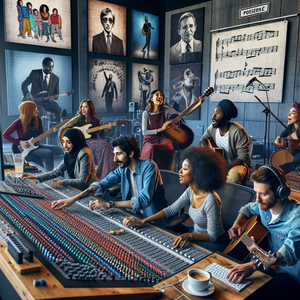The Spotify Effect: How Data is Shaping Music Trends

At the core of Spotify’s success is its algorithmic approach to playlist curation and music recommendations. By meticulously analyzing user behavior—such as which tracks are streamed, skipped, or saved—Spotify crafts personalized playlists like "Discover Weekly" and "Release Radar." These playlists are instrumental in introducing listeners to new artists, acting as powerful tools for music discovery that can catapult unknown musicians into the limelight. A prime example of this phenomenon is the rise of Lizzo, whose career gained significant momentum after being featured on the "New Music Friday" playlist. This exposure connected her music with millions of potential fans and led to a rapid ascent in her popularity. Similarly, Billie Eilish's unique sound and style were amplified by Spotify’s recommendation algorithms, allowing her to resonate with a younger demographic and ultimately win multiple Grammy Awards. Such case studies underscore the potential of data to unlock opportunities for artists who might otherwise go unnoticed in a crowded market.
Influencing Music Production and Trends
The influence of Spotify's data is not limited to music discovery; it extends to the production of music itself. Record labels and artists are increasingly turning to streaming data as a vital resource for creative guidance. Insights gleaned from user interactions can reveal which song structures, rhythmic patterns, or lyrical themes resonate most with audiences, steering artists in their songwriting. This trend has culminated in a more formulaic approach to pop music, where catchy hooks and relatable narratives dominate the airwaves. A prominent example is the "TikTok effect," where songs that achieve viral status on the social media platform frequently ascend to the top of Spotify charts. The data-driven nature of both platforms means that artists are now crafting music with the intention of it being shared and remixed online, blurring the lines between traditional music consumption and digital engagement. This interplay exemplifies how data not only shapes listener preferences but also drives the creation of music tailored for specific platforms and audiences.
The Democratization of Music Consumption
One of the most profound changes brought about by Spotify’s data analytics is the democratization of music consumption. In the era of traditional gatekeepers, major record labels determined which artists received exposure and which music was promoted. However, the rise of streaming platforms has shifted this dynamic, enabling independent artists to leverage data to connect directly with audiences, effectively bypassing the traditional barriers to entry. Spotify offers artists a suite of tools to analyze their own data, providing insights into their listener demographics and geographic locations. This information empowers artists to refine their marketing strategies and plan tours effectively, enhancing their autonomy and control over their careers. For instance, an independent band can use streaming data to identify cities where they have cultivated a growing fan base, allowing them to target those areas for future performances and maximize their outreach.
The Spotify effect illustrates the transformative power of data within the music industry. From reshaping music discovery to influencing production trends and democratizing artist opportunities, data analytics is integral to today’s music landscape. As the industry continues to evolve, the relationship between data and creativity will become increasingly pronounced, paving the way for exciting new possibilities for artists and listeners alike. The future of music is not solely about the melodies and rhythms we enjoy but also about the data that drives those sounds, making this an exhilarating time to engage with the ever-changing musical environment.
Music Data Analyst
Spotify, Apple Music, Warner Music Group
Job Responsibilities
Analyze user engagement metrics to identify trends in music consumption and artist popularity.
Collaborate with marketing and content teams to optimize playlists and promotional strategies based on data insights.
Proficiency in statistical analysis software (e.g., R, Python) and data visualization tools (e.g., Tableau).
Music Marketing Strategist
Universal Music Group, Sony Music, independent record labels
Job Responsibilities
Develop and execute marketing campaigns leveraging streaming data to target specific demographics and increase artist visibility.
Conduct market research to understand audience preferences and identify emerging trends in the music industry.
Strong understanding of social media platforms and content creation strategies, particularly for music promotion.
Playlist Curator
Spotify, Tidal, YouTube Music
Job Responsibilities
Curate and manage playlists that align with listener preferences, utilizing data analytics to inform selections and updates.
Collaborate with artists and labels to promote new releases through featured playlists and editorial content.
Excellent knowledge of music genres, trends, and the ability to engage with diverse audiences.
Music Production Specialist
Major record labels, independent studios, music production companies
Job Responsibilities
Use data-driven insights to guide artists in songwriting and production choices, focusing on trending musical elements and structures.
Collaborate with producers and sound engineers to create tracks that resonate with current listener preferences.
Familiarity with music production software (e.g., Ableton Live, Pro Tools) and a strong understanding of music theory.
Digital Marketing Analyst in Music
Independent record labels, streaming platforms, music marketing agencies
Job Responsibilities
Analyze digital marketing campaigns for music releases and measure their effectiveness using key performance indicators (KPIs).
Utilize SEO and SEM strategies to enhance online visibility for artists and their music on various platforms.
Proficiency in marketing analytics tools (e.g., Google Analytics) and a strong understanding of the digital landscape in the music industry.


